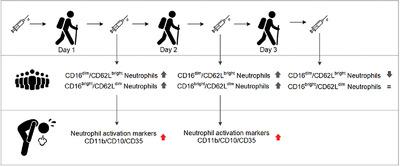当前位置:
X-MOL 学术
›
J. Leukoc. Biol.
›
论文详情
Our official English website, www.x-mol.net, welcomes your
feedback! (Note: you will need to create a separate account there.)
Analysis of human neutrophil phenotypes as biomarker to monitor exercise‐induced immune changes
Journal of Leukocyte Biology ( IF 3.6 ) Pub Date : 2020-09-06 , DOI: 10.1002/jlb.5a0820-436r Roy Spijkerman 1, 2, 3 , Lillian Hesselink 1, 2 , Carlo Bertinetto 4 , Coen Cwg Bongers 5 , Falco Hietbrink 1 , Nienke Vrisekoop 2, 3 , Luke Ph Leenen 1 , Maria Te Hopman 5 , Jeroen J Jansen 4 , Leo Koenderman 2, 3
Journal of Leukocyte Biology ( IF 3.6 ) Pub Date : 2020-09-06 , DOI: 10.1002/jlb.5a0820-436r Roy Spijkerman 1, 2, 3 , Lillian Hesselink 1, 2 , Carlo Bertinetto 4 , Coen Cwg Bongers 5 , Falco Hietbrink 1 , Nienke Vrisekoop 2, 3 , Luke Ph Leenen 1 , Maria Te Hopman 5 , Jeroen J Jansen 4 , Leo Koenderman 2, 3
Affiliation

|
The amplitude of the innate immune response reflects the degree of physiological stress imposed by exercise load. An optimal balance of exercise intensity and duration is essential for a balanced immune system and reduces the risk of dysfunction of the immune system. Therefore, it is hypothesized that neutrophils, as key players in the innate immune system, can be used as biomarker in detecting overtraining. The aim was to monitor the state of the innate immune system by phenotyping neutrophils during consecutive bouts of prolonged exercise. Study subjects were recruited from a cohort of walkers participating in a walking event on 3 consecutive days. Participants with immune deficiencies were excluded. Questionnaires to determine the physiological status of the participants were completed. Analysis of neutrophil receptor expression was done by a point‐of‐care fully automated flow cytometer. A total of 45 participants were recruited, of whom 39 participants were included for data analysis. Study participants had a median age of 64 (58‐70) years. The absolute numbers CD16dim/CD62Lbright and CD16bright/CD62Ldim neutrophils were increased after the first 2 days of exercise followed by an adaptation/normalization after the third day. Participants with activated neutrophils (high CD11b expression) had an impaired physical feeling indicated by the participant on a lower visual analog scale compared to participants who did not have activated neutrophils (P = 0.017, P = 0.022). Consecutive days of prolonged exercise results in an initial systemic innate immune response, followed by normalization/adaptation. Increased neutrophil activation was associated with impaired physical feeling measured by a validated VAS score indicated by the participant. Fully automated point‐of‐care flow cytometry analysis of neutrophil phenotypes in a field laboratory might be a useful tool to monitor relevant differences in the systemic innate immune response in response to exercise.
中文翻译:

分析人类嗜中性粒细胞表型作为生物标记,以监测运动引起的免疫变化
先天免疫反应的幅度反映了运动负荷施加的生理压力的程度。运动强度和持续时间的最佳平衡对于平衡免疫系统至关重要,并可以降低免疫系统功能障碍的风险。因此,假设嗜中性粒细胞作为先天免疫系统中的关键角色,可以用作检测过度训练的生物标志物。目的是通过在连续的长时间运动中嗜中性粒细胞表型来监测先天免疫系统的状态。研究对象是从连续3天参加步行活动的一群步行者中招募的。免疫缺陷的参与者被排除在外。确定参与者生理状态的问卷已经完成。中性粒细胞受体表达的分析是通过即时护理全自动流式细胞仪进行的。总共招募了45名参与者,其中39名参与者被纳入数据分析。研究参与者的中位年龄为64(58-70)岁。绝对数CD16暗淡/ CD62L亮和CD16亮/ CD62L暗淡嗜中性粒细胞的第2天的锻炼,随后后第三天的自适应/归一化后增加。与未激活嗜中性粒细胞的参与者相比,激活嗜中性粒细胞(CD11b表达高)的参与者的身体感觉受损,其视觉模拟评分较低(P = 0.017,P = 0.022)。连续长时间的运动导致最初的全身性先天免疫反应,然后恢复正常/适应。中性粒细胞活化增加与身体感觉受损有关,后者由参与者指示的经验证的VAS评分测得。在野外实验室对嗜中性粒细胞表型进行全自动即时流式细胞术分析,可能是一种有用的工具,可以监测运动引起的系统性先天免疫反应的相关差异。
更新日期:2020-09-06
中文翻译:

分析人类嗜中性粒细胞表型作为生物标记,以监测运动引起的免疫变化
先天免疫反应的幅度反映了运动负荷施加的生理压力的程度。运动强度和持续时间的最佳平衡对于平衡免疫系统至关重要,并可以降低免疫系统功能障碍的风险。因此,假设嗜中性粒细胞作为先天免疫系统中的关键角色,可以用作检测过度训练的生物标志物。目的是通过在连续的长时间运动中嗜中性粒细胞表型来监测先天免疫系统的状态。研究对象是从连续3天参加步行活动的一群步行者中招募的。免疫缺陷的参与者被排除在外。确定参与者生理状态的问卷已经完成。中性粒细胞受体表达的分析是通过即时护理全自动流式细胞仪进行的。总共招募了45名参与者,其中39名参与者被纳入数据分析。研究参与者的中位年龄为64(58-70)岁。绝对数CD16暗淡/ CD62L亮和CD16亮/ CD62L暗淡嗜中性粒细胞的第2天的锻炼,随后后第三天的自适应/归一化后增加。与未激活嗜中性粒细胞的参与者相比,激活嗜中性粒细胞(CD11b表达高)的参与者的身体感觉受损,其视觉模拟评分较低(P = 0.017,P = 0.022)。连续长时间的运动导致最初的全身性先天免疫反应,然后恢复正常/适应。中性粒细胞活化增加与身体感觉受损有关,后者由参与者指示的经验证的VAS评分测得。在野外实验室对嗜中性粒细胞表型进行全自动即时流式细胞术分析,可能是一种有用的工具,可以监测运动引起的系统性先天免疫反应的相关差异。











































 京公网安备 11010802027423号
京公网安备 11010802027423号